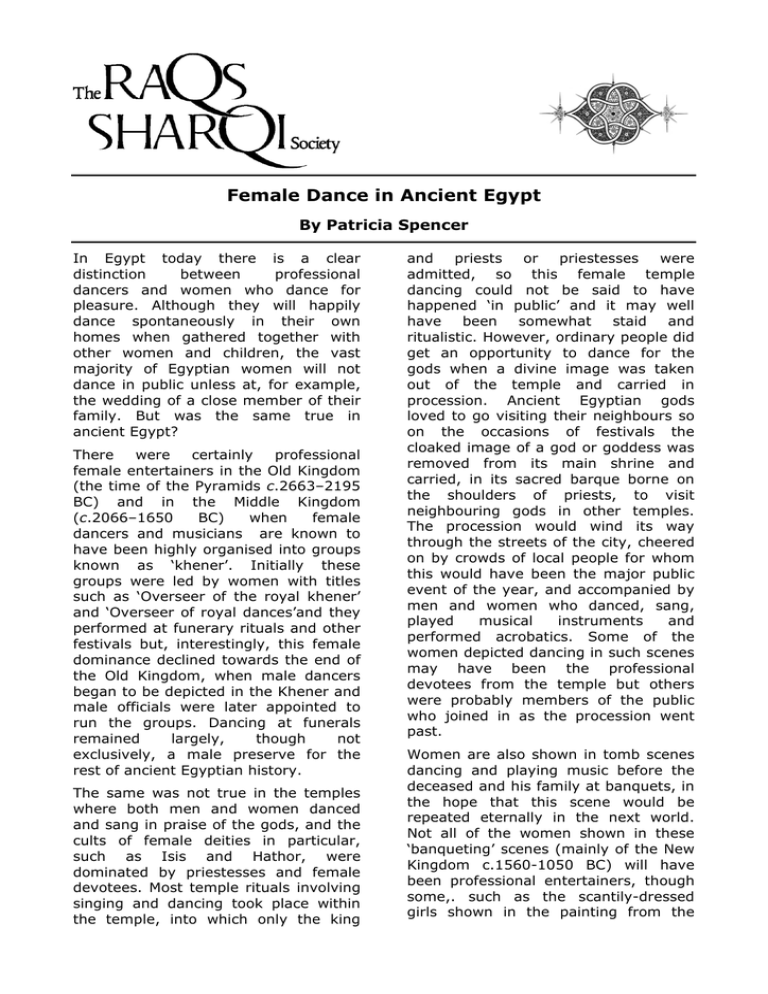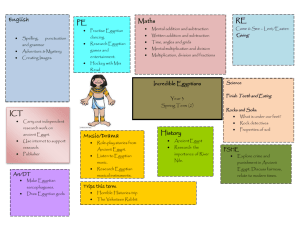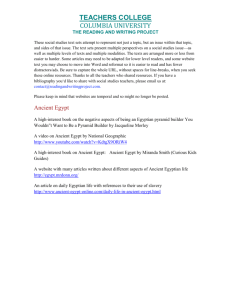Female Dance in Ancient Egypt By Patricia Spencer
advertisement

Female Dance in Ancient Egypt By Patricia Spencer In Egypt today there is a clear distinction between professional dancers and women who dance for pleasure. Although they will happily dance spontaneously in their own homes when gathered together with other women and children, the vast majority of Egyptian women will not dance in public unless at, for example, the wedding of a close member of their family. But was the same true in ancient Egypt? There were certainly professional female entertainers in the Old Kingdom (the time of the Pyramids c.2663–2195 BC) and in the Middle Kingdom (c.2066–1650 BC) when female dancers and musicians are known to have been highly organised into groups known as ‘khener’. Initially these groups were led by women with titles such as ‘Overseer of the royal khener’ and ‘Overseer of royal dances’and they performed at funerary rituals and other festivals but, interestingly, this female dominance declined towards the end of the Old Kingdom, when male dancers began to be depicted in the Khener and male officials were later appointed to run the groups. Dancing at funerals remained largely, though not exclusively, a male preserve for the rest of ancient Egyptian history. The same was not true in the temples where both men and women danced and sang in praise of the gods, and the cults of female deities in particular, such as Isis and Hathor, were dominated by priestesses and female devotees. Most temple rituals involving singing and dancing took place within the temple, into which only the king and priests or priestesses were admitted, so this female temple dancing could not be said to have happened ‘in public’ and it may well have been somewhat staid and ritualistic. However, ordinary people did get an opportunity to dance for the gods when a divine image was taken out of the temple and carried in procession. Ancient Egyptian gods loved to go visiting their neighbours so on the occasions of festivals the cloaked image of a god or goddess was removed from its main shrine and carried, in its sacred barque borne on the shoulders of priests, to visit neighbouring gods in other temples. The procession would wind its way through the streets of the city, cheered on by crowds of local people for whom this would have been the major public event of the year, and accompanied by men and women who danced, sang, played musical instruments and performed acrobatics. Some of the women depicted dancing in such scenes may have been the professional devotees from the temple but others were probably members of the public who joined in as the procession went past. Women are also shown in tomb scenes dancing and playing music before the deceased and his family at banquets, in the hope that this scene would be repeated eternally in the next world. Not all of the women shown in these ‘banqueting’ scenes (mainly of the New Kingdom c.1560-1050 BC) will have been professional entertainers, though some,. such as the scantily-dressed girls shown in the painting from the tomb of Nebamun, almost certainly were. However, occasionally the names and titles of performing women are given in these scenes and it can be seen that some were relations of the deceased. In these cases, it is much more likely that what we have here are scenes similar to those at a modern Egyptian wedding where close female members of the family dance to honour their relation. Such high status women are unlikely to have been professional performers and their willingness to be depicted dancing on tomb walls is no indication that they danced in public in real life as the scenes in tomb chapels were only ever intended to be seen by family members bringing offerings or (magically) by the deceased. We know from textual evidence that there were itinerant performers, both male and female, in ancient Egypt. They would tour the country dancing and singing at the major festivals and celebrations and were paid for their performances in kind, with food and other goods. Since there was no ‘theatre’ in ancient Egypt, their performances would always have been connected with some kind of religious, family or funerary event. These performers were probably family groups, passing their skills down from one generation to the next. Texts and scenes show that there were also foreign entertainers, who came from Nubia (the area of modern-day southern Egypt/northern Sudan) or from the countries of the Near East, but the majority of professional entertainers, both men and women, would have been native Egyptians. From the evidence which has survived, therefore, it is tempting to suggest that the situation in Egypt in antiquity was similar to that prevailing today and that there were ‘professional’ female dancers attached to the temples and also in secular itinerant groups, but that the majority of women would probably only have danced in family situations. Interestingly there is no evidence from ancient Egypt for any kind of wedding ceremony or celebration (though it is hard to believe that they did not happen) so the occasion when modern Egyptian women are most likely to dance in public - a family wedding - is unknown in the ancient record. The dances depicted in Egyptian scenes appear, to our eyes, stiff and stylised since ancient Egyptian artistic conventions were very rigid, with strict rules about how a human figure had to be depicted and a ‘canon of proportions’ to which all Egyptian artists had to adher. Consequently, it was very hard for an Egyptian artist or sculptor to show any individuality and sponteneity in his depictions of dance and entertainment. In addition, little of what we know as ‘art’ from ancient Egypt was conceived and executed ‘for art’s sake’ - it was all functional and was designed, in the case of funerary scenes, to depict the next world or, for temple scenes, to show the rituals which were necessary for Egypt to flourish in this world. The option of just depicting a natural scene of people enjoying themselves was rarely open to an Egyptian artist. However, over the three thousand years that the ancient Egyptian civilisation lasted there were occasionally some periods, and some places, where there was a loosening of rigid controls and artists were able to depict dancers in a more naturalistic style. From their work it can be seen that ancient Egyptian women enjoyed dancing just as much as their descendents today. Patricia Spencer is Director of the Egypt Exploration Society This article first appeared in May 2005 edition of ‘Events’, the Society’s former newsletter. We hope you have found it interesting and informative, if you wish to use or reproduce any part of it, please respect copyright by crediting the author (Patricia Spencer) and the source (Raqs Sharqi Society). Thank you. Raqs Sharqi Society, PO Box 42021, London E5 8WJ, UK Tel/Fax: +44 (0) 20 8980 6778 E-mail: dance@raqssharqisociety.org www.raqssharqisociety.org






